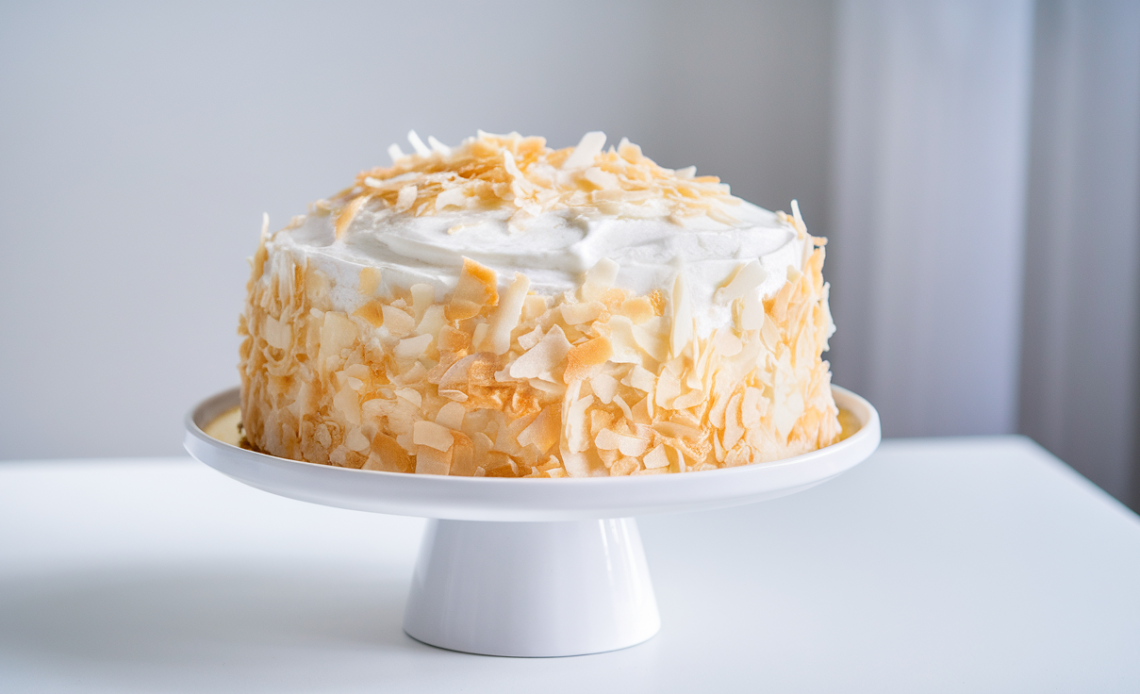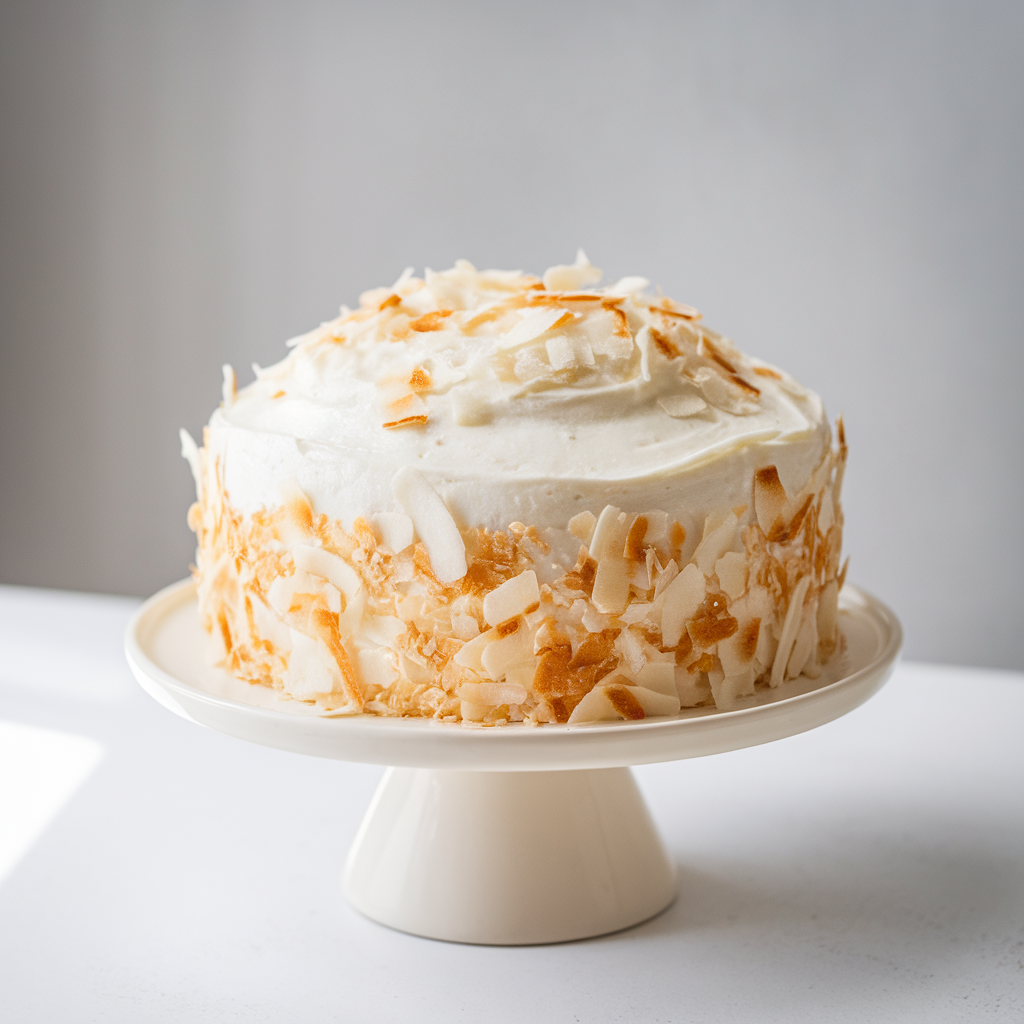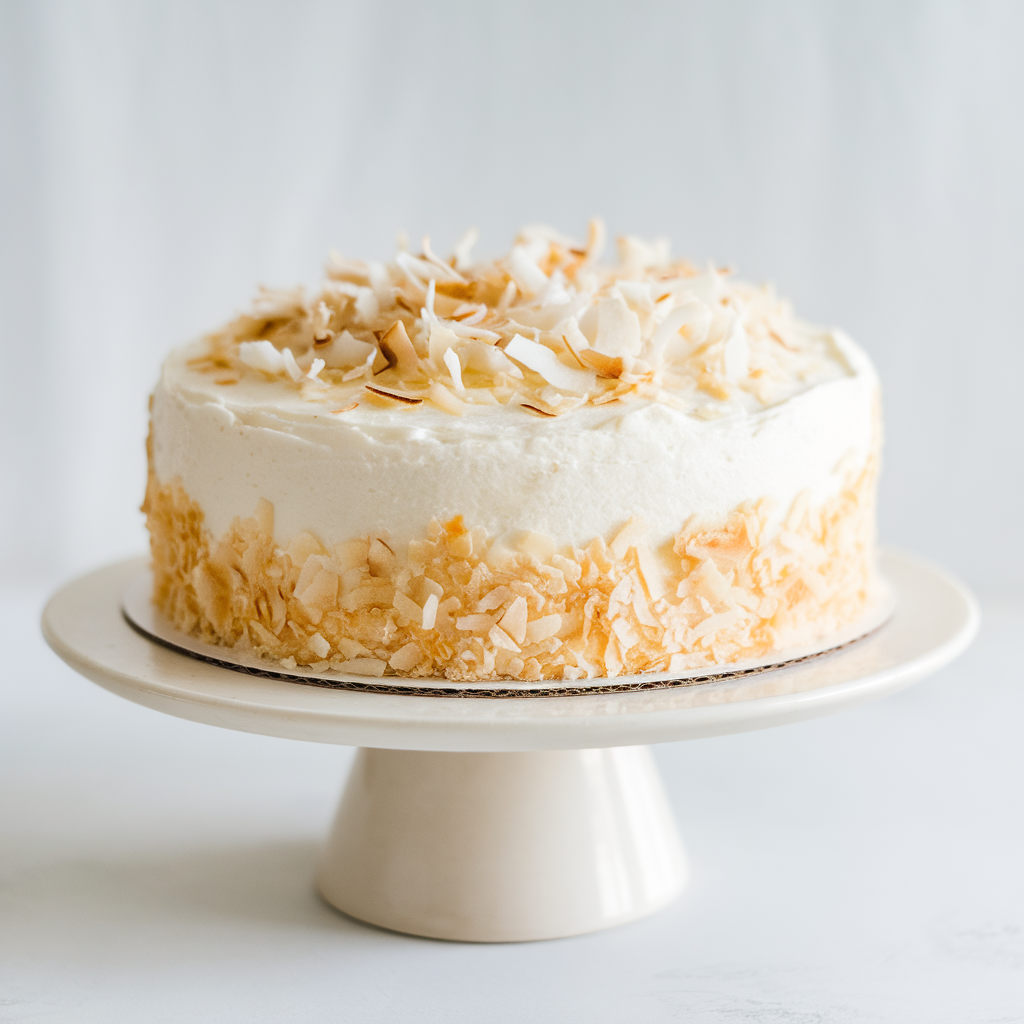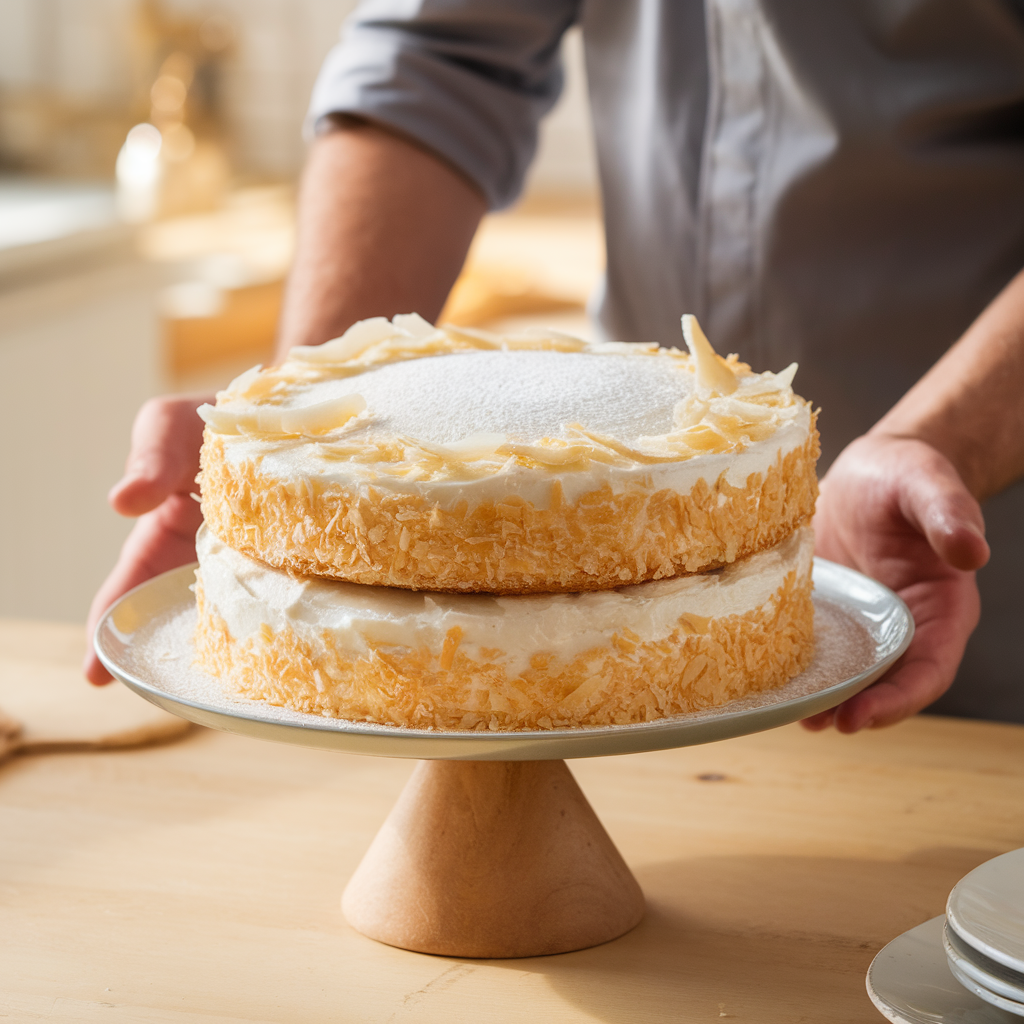
Imagine biting into a cake so light and fluffy it feels like you’re eating a cloud — only better, because it’s bursting with rich coconut flavor. That’s the magic of the Coconut Cloud Cake, an irresistible white coconut cake that perfectly balances tropical flavor and delicate texture. Whether you’re looking for a simple cloud cake recipe to wow your family or a stunning coconut sheet cake for a party, this recipe will become your new go-to.
This article dives deep into the secrets of making the perfect Coconut Cloud Cake, with practical baking tips, ingredient insights, and exciting ideas like adding luscious cheesecake caramel to transform this into a next-level treat. Gluten-free? No problem. We’ve got that covered too. By the end, you’ll be ready to create a show-stopping delish cake that keeps everyone coming back for seconds.
What Is Coconut Cloud Cake? Why Is It So Popular?
The Coconut Cloud Cake is not just any coconut cake — it’s a textural phenomenon. Unlike the dense, sometimes dry coconut cakes you might find at a bakery, this cake is airy and tender, almost like biting into a soft, sweet cloud.
The “cloud” in the name refers to the cake’s lightness achieved by folding in whipped egg whites, which trap air and create a fluffy crumb. The shredded coconut and coconut milk give it a moist, tropical profile, while the frosting usually features cream cheese or whipped coconut cream, balancing sweetness and tang.
This cake shines because:
- It’s ultra-moist but never heavy or greasy.
- The coconut flavor is genuine and vibrant, not artificial.
- It’s adaptable — you can bake it as a sheet cake, round layers, cupcakes, or even a loaf cake.
- It can be made gluten-free and dairy-free with simple swaps.
- It looks stunning topped with toasted coconut flakes, making it perfect for celebrations.
The Essential Ingredients of the Perfect White Coconut Cake
To nail this Coconut Cloud Cake masterpiece, you need the right ingredients and quality matters here:
1. Flour — The Foundation
Traditional recipes use all-purpose flour, but if you want to create a GF cake, a well-balanced gluten-free flour blend or almond flour works well. These alternatives keep the cake tender and moist. Be sure to add a bit of xanthan gum if your GF blend doesn’t contain it, to help bind the cake and keep its structure.
2. Sugar — Sweetness Without Overpowering
Granulated sugar is the classic choice, but you can experiment with coconut sugar or superfine sugar for subtle texture variations. Avoid brown sugar, which might weigh down the batter and darken the cake.
3. Eggs — The Lift Makers
Eggs are crucial here — especially separating the yolks from whites. The whites get whipped into stiff peaks and folded into the batter, introducing air that results in the iconic “cloud” fluffiness.
4. Fat — Butter or Oil
Butter provides flavor and richness, giving the cake a velvety crumb. Some recipes swap some or all butter for coconut oil to enhance the coconut profile and keep the cake moist.
5. Coconut Milk — The Tropical Moisture
Coconut milk or coconut cream is a game-changer for this cake. The full-fat version adds moisture and authentic coconut flavor that water or regular milk can’t match. Plus, the natural fat content keeps the cake luscious.
6. Shredded Coconut — Texture and Taste
Use unsweetened, flaked or shredded coconut to fold into the batter for texture. It’s that tiny burst of chewiness that makes each bite exciting. Toast some for the topping to add crunch and a deeper flavor.
7. Leavening Agents — The Rise
Baking powder and baking soda make sure the cake rises properly. Baking soda also helps neutralize acidity, which can come from the coconut milk or buttermilk substitutes if used.
8. Flavor Extracts — The Aroma
Pure vanilla extract is a must, but coconut extract elevates the tropical vibe. A touch of almond extract is optional but adds a lovely, nutty nuance.
9. Frosting — Cream Cheese or Coconut Whipped Cream
Cream cheese frosting is a classic pairing with coconut cake — its tang cuts through the sweetness beautifully. For a dairy-free option, coconut whipped cream or vegan cream cheese frosting work wonders.
10. Optional Extras — Cheesecake Caramel Drizzle
This decadent sauce is a modern twist that combines smooth cheesecake tanginess with buttery caramel sweetness — an irresistible finish to your Coconut Cloud Cake.

Step-By-Step Coconut Cloud Cake Recipe
Ready to bake your own cloud of coconut joy? Follow these detailed steps for the best results.
Ingredients Recap:
For the Cake:
- 2 ½ cups all-purpose flour or gluten-free flour blend
- 2 ½ tsp baking powder
- ½ tsp baking soda
- ½ tsp salt
- 1 cup unsalted butter, softened (or coconut oil for dairy-free)
- 1 ¾ cups granulated sugar
- 4 large eggs, separated
- 1 tsp vanilla extract
- 1 tsp coconut extract
- 1 cup full-fat coconut milk
- 1 cup unsweetened shredded coconut
For the Frosting:
- 8 oz cream cheese, softened (use vegan cream cheese for dairy-free)
- ½ cup unsalted butter, softened (or coconut oil)
- 4 cups powdered sugar, sifted
- 1 tsp vanilla extract
- ½ cup shredded coconut, toasted
For Optional Cheesecake Caramel Sauce:
- ½ cup sugar
- ¼ cup heavy cream (or coconut cream)
- 1 tbsp butter (or vegan butter)
- ¼ tsp sea salt
- 2 oz cream cheese, softened
Directions:
1. Prep Your Workspace and Oven
Preheat the oven to 350°F (175°C). Grease and flour two 9-inch round cake pans, or line a 9×13-inch sheet pan with parchment paper for a coconut sheet cake version.
2. Mix Dry Ingredients
Sift together the flour, baking powder, baking soda, and salt in a medium bowl. This ensures even distribution and a lighter texture.
3. Cream Butter and Sugar
In a large bowl, beat the butter (or coconut oil) and sugar until pale and fluffy — about 3-5 minutes. This is where the air starts to get incorporated, setting up the cloud effect.
4. Add Egg Yolks and Extracts
Add egg yolks one at a time, beating well after each addition. Then stir in vanilla and coconut extracts.
5. Alternate Dry Ingredients and Coconut Milk
Add the dry ingredients and coconut milk alternately, starting and ending with the dry mix. Mix gently after each addition. Overmixing will toughen the cake.

6. Whip Egg Whites to Stiff Peaks
In a separate, clean bowl, beat egg whites until stiff peaks form. This means when you lift the whisk, the peaks stand straight up without falling.
7. Fold Egg Whites Into Batter
Gently fold the egg whites into the batter with a spatula. Do this slowly and carefully to preserve the airiness.
8. Fold in Shredded Coconut
Add shredded coconut and fold gently until evenly distributed.
9. Bake
Pour batter into prepared pans. Bake for 30-35 minutes (round pans) or 25-30 minutes (sheet pan). Check doneness with a toothpick — it should come out clean.
10. Cool Completely
Allow cakes to cool in pans for 10 minutes, then turn out onto wire racks to cool completely before frosting.
Frosting and Assembly
11. Prepare the Frosting
Beat cream cheese and butter until smooth. Gradually add powdered sugar and vanilla, beating until fluffy.
12. Toast Coconut for Garnish
Toast shredded coconut in a dry skillet over medium heat, stirring frequently, until golden brown and fragrant. Let cool.
13. Assemble Cake
If using round layers, level each layer if needed. Spread frosting evenly between layers and on top and sides of cake.
14. Garnish
Sprinkle toasted coconut over the top and sides for crunch and visual appeal.
Optional Cheesecake Caramel Sauce
- Heat sugar in a saucepan over medium heat, stirring until it melts and turns amber.
- Carefully add heavy cream or coconut cream — it will bubble up. Stir until smooth.
- Remove from heat and stir in butter, sea salt, and cream cheese until creamy and smooth.
- Cool slightly and drizzle over frosted cake for a luxurious finish.
Pro Tips to Perfect Your Coconut Cloud Cake
- Whip those egg whites well. The cake’s signature fluffiness depends on this step. Make sure your bowl and whisk are grease-free for best results.
- Use room temperature ingredients. Butter, eggs, and coconut milk at room temp emulsify better, making the batter smooth.
- Don’t rush folding. Be gentle folding in whipped egg whites and coconut to keep the airy texture.
- Try coconut oil for a more intense flavor and moist crumb. You can replace butter 1:1, but melt and cool it first.
- For a truly gluten-free cake, make sure your baking powder is GF. Some brands include wheat starch.
- Toast coconut flakes last-minute for garnish. It adds a nice golden crunch that complements the soft cake.
- Add a splash of rum or coconut rum extract to frosting or batter for adult parties. It adds depth without overpowering.
- Experiment with texture by folding in macadamia nuts or white chocolate chips.

Serving Ideas: How to Enjoy Your Coconut Cloud Cake
- Classic celebration cake: Dress it with coconut cream and toasted coconut for weddings, birthdays, or showers.
- Coconut sheet cake: Bake in a single pan and cut into squares — perfect for casual gatherings or potlucks.
- Cupcakes: Make individual coconut cloud cupcakes for portion control and easy serving.
- With fresh tropical fruit: Serve with slices of pineapple, mango, or kiwi for a fresh balance.
- Drizzled with cheesecake caramel: Elevate your cake to a gourmet dessert experience.
- Paired with coffee or tropical cocktails: Coconut pairs beautifully with espresso, rum cocktails, or even chai tea.
Coconut Cloud Cake for Special Diets: Gluten-Free and Dairy-Free
You don’t have to miss out if you’re gluten intolerant or dairy-free. With the right swaps:
- Gluten-free: Use an all-purpose GF flour blend with xanthan gum. Check your baking powder. Almond flour can add moistness but may require additional binding agents.
- Dairy-free: Substitute butter with coconut oil or vegan butter. Use dairy-free cream cheese alternatives and coconut cream in place of heavy cream for the caramel sauce.
- Egg-free options: More challenging but can experiment with aquafaba (chickpea water) whipped to stiff peaks instead of egg whites.
Why This Recipe Is a Game-Changer for Coconut Cake Lovers
The Coconut Cloud Cake recipe strikes the perfect balance between:
- Tradition and innovation: Classic coconut cake ingredients meet modern techniques like folding in whipped egg whites.
- Texture and flavor: Light as air yet rich with genuine coconut taste.
- Flexibility: Bake as a sheet cake, layered rounds, or cupcakes, gluten-free or not, with or without decadent caramel drizzle.
- Visual wow: The pristine white crumb and frosting topped with toasted coconut make it an elegant centerpiece.
This cake ticks all the boxes — flavor, appearance, texture, and adaptability.
Frequently Asked Questions (FAQ)
Q: Can I prepare the cake batter ahead of time?
A: It’s best to bake immediately after folding in egg whites to retain airiness. However, you can prepare dry and wet ingredients separately in advance.
Q: How long does the Coconut Cloud Cake keep?
A: Refrigerated and covered, it lasts about 3-4 days. Bring to room temperature before serving for best flavor.
Q: Can I use frozen shredded coconut?
A: Yes, but let it thaw and drain excess moisture to avoid soggy cake.
Q: How do I prevent the frosting from sliding?
A: Make sure your cake is fully cooled and crumb-coated with a thin layer of frosting before applying the final coat.
Q: What’s the best way to toast coconut?
A: Toast in a dry skillet over medium heat, stirring constantly for 3-5 minutes until golden and fragrant. Don’t walk away; it burns fast!
Final Thoughts: Your Next Baking Adventure Awaits
If you’ve been searching for a cake that feels light, tastes like a tropical vacation, and looks stunning enough for any celebration, this Coconut Cloud Cake is your answer. It’s the perfect blend of soft, fluffy crumb and authentic coconut flavor, topped with creamy frosting and optional cheesecake caramel drizzle for an indulgent finish.
No matter your skill level or dietary needs, this cloud cake recipe offers flexibility and foolproof steps that ensure success every time. Plus, with variations from sheet cakes to cupcakes, you can make it your own signature dessert.
So, what are you waiting for? Grab those ingredients and let’s bake some clouds! ☁️🥥🍰




